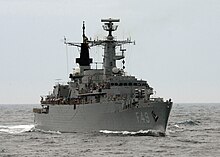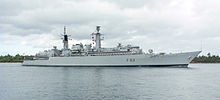Broadsword class
|
HMS Cumberland
|
||||||||||||||
|
||||||||||||||
|
||||||||||||||
|
||||||||||||||
|
||||||||||||||
The Broadsword class (Type 22) ships are former guided missile frigates of the British Royal Navy . They were put into service for anti -submarine hunting between 1979 and 1990 , but were later developed into multi-purpose frigates. The last of a total of fourteen ships of this class built was decommissioned by the Royal Navy in 2011. Two ships of the second series of the Type 22 are currently in service under the Romanian flag, another under the Chilean flag and three ships of the first series form the Greenhalgh class in the Brazilian Navy .
history
In the early 1970s, the Royal Navy commissioned Yarrow Shipbuilders (now BAE SYSTEMS ) to build a frigate for submarine hunting. A total of 24 ships were ordered. While the first four ships (Batch I) were only 131 m long and had a displacement of 4,400 tons, the following six ships (Batch II) were built with an elongated hull and a correspondingly larger displacement. The extension made it possible to install additional systems for locating submarines. In 1981 the project was stopped for cost reasons after only ten of the 24 ordered frigates had been delivered. However, after a total of four destroyers and frigates of other classes had been sunk in the Falklands War , another four Broadsword- class frigates were ordered as replacements in 1984 . The extended ships of Batch II were taken as the basis for this third series (Batch III). A major change was that the frigates now received a 114 mm cannon on the bow instead of the Exocet rocket launchers. In addition, new air defense systems and anti-ship missiles of the Harpoon type were installed. The last of the four additional ships entered service in 1990.

With the end of the Cold War , the tasks of the ships changed. While submarine hunting continues to play an important role, this task has increasingly been transferred to the Duke-class frigates . The Broadsword class was now used primarily for patrol and escort missions. The frigates became the main tool of the Royal Navy in worldwide crisis and war missions. For these new tasks, however, a substantial modernization of the first ten ships was necessary. In 1994 the Royal Navy decided against an expensive upgrade and instead gave preference to the new Duke-class frigates. In 1995 the HMS Broadsword was the first ship to be retired. After the completion of all Duke class ships in 2002, the HMS Coventry, the last ship of the first two series, was decommissioned.
Thus, only the four ships of Batch III, equipped with more modern systems from the start, remained in service with the Royal Navy. They were retrofitted again, with the guided missile systems being brought up to date with the latest technology. In addition, they received a new, more efficient drive. Considerations to also equip the four frigates with cruise missiles were then given up in favor of the Daring class . The Future Surface Combatant project, originally intended as a successor, was canceled in 2005 and the Royal Navy instead announced that the four frigates, which were considered to be very reliable and durable with little maintenance, would not be retired until between 2015 and 2018 . According to the Strategic Defense and Security Review 2010 (SDSR 2010) , the Type 26, which is now intended as the future frigate class of the Royal Navy, should only replace the Duke class and the Broadsword class should be retired without replacement by 2018. At the end of 2010, however, it was decided to decommission all four remaining ships in early 2011.
After much disappointment with previous types of frigate, the Broadsword-class has proven to be a success for the Royal Navy. Seven of the frigates retired in Great Britain were or are now successfully in service in Brazil, Romania and Chile.
units
Batch I
After the previously built frigates of the Amazon class had names beginning with the letter "A", the ships of Batch I of the Broadsword class were given names that began with "B".
| Identifier | Surname | Shipyard | Keel laying | Launch | In service | Off-duty | Whereabouts |
|---|---|---|---|---|---|---|---|
| F88 | HMS Broadsword | Yarrow | 7th February 1975 | May 12, 1976 | May 4th 1978 | March 31, 1995 | to Brazil, Greenhalgh (F46) |
| F89 | HMS Battleaxe | Yarrow | 4th February 1976 | May 18, 1977 | March 29, 1980 | 1997 | to Brazil, Rademaker (F49) |
| F90 | HMS Brilliant | Yarrow | March 25, 1977 | December 15, 1978 | May 15, 1981 | 1996 | to Brazil, Dodsworth (F47) |
| F91 | HMS Brazen | Yarrow | August 18, 1978 | March 4th 1980 | 2nd July 1982 | 1996 | to Brazil, Bosisio (F48) |
Batch II
The first three ships of the next batch were also given names that began with "B". The last three Batch II units, on the other hand, had names of English cities, with the last two names previously being carried by destroyers of the Sheffield class that had been sunk in the Falklands War .
| Identifier | Surname | Shipyard | Keel laying | Launch | In service | Off-duty | Whereabouts |
|---|---|---|---|---|---|---|---|
| F92 | HMS boxer | Yarrow | November 1, 1979 | 17th June 1981 | December 22, 1983 | August 4, 1999 | Sunk in 2004 as a target ship |
| F93 | HMS Beaver | Yarrow | June 20, 1980 | May 8, 1982 | December 13, 1984 | May 1, 1999 | Retired and scrapped in 2001 |
| F94 | HMS Brave | Yarrow | May 24, 1982 | November 19, 1983 | 4th July 1986 | March 23, 1999 | Sunk in 2004 as a target ship |
| F95 | HMS London | Yarrow | February 7, 1983 | October 27, 1984 | 5th June 1987 | January 14, 1999 | to Romania, Regina Maria (F222) |
| F96 | HMS Sheffield | Swan Hunter | March 29, 1984 | March 26, 1986 | July 26, 1988 | November 15, 2002 | to Chile, Almirante Williams (FF-19) |
| F98 | HMS Coventry | Swan Hunter | March 29, 1984 | April 8, 1986 | October 14, 1988 | January 17, 2002 | to Romania, Regele Ferdinand (F221) |
Batch III
The ships of Batch III were given names again, which began with the same initial letter, this time "C". These were geographical names. The home port is Devonport . The decommissioning began in early 2011.
| Identifier | Surname | Shipyard | Keel laying | Launch | In service | Off-duty | Whereabouts |
|---|---|---|---|---|---|---|---|
| F99 | HMS Cornwall | Yarrow | September 19, 1983 | October 14, 1985 | April 23, 1988 | June 30, 2011 | Scrapped in 2013 |
| F85 | HMS Cumberland | Yarrow | October 12, 1984 | June 21, 1986 | June 10, 1989 | June 23, 2011 | Scrapped in 2013 |
| F86 | HMS Campbeltown | Cammell Laird | 4th December 1985 | October 7, 1987 | May 27, 1989 | April 7, 2011 | Scrapped in 2013 |
| F87 | HMS Chatham | Swan Hunter | May 12, 1986 | January 20, 1988 | May 4th 1990 | February 8, 2011 | Scrapped in 2013 |
Whereabouts
Brazil bought the first one in 1995 and the three remaining units of the first construction lot the following year. After the former type ship HMS Broadsword was renamed Greenhalgh there , the ships are listed as Greenhalgh class by the Brazilian Navy . They each bear the name of a former Brazilian naval officer and, as anti-ship missiles, run the French Exocet, initially the MM38 series and, from 2010–2012, the remaining three units have been modernized to the MM40.
| Identifier | Surname | Commissioning | Decommissioning | Whereabouts |
|---|---|---|---|---|
| F46 | Greenhalgh | June 30, 1995 | active | |
| F47 | Dodsworth | August 31, 1996 | March 11, 2004 | reserve |
| F48 | Bosisio | August 31, 1996 | 29th September 2015 | Target ship, sunk in 2017 |
| F49 | Rademaker | April 30, 1997 | active |
Chile bought the former Sheffield and the Chilean Navy put it into service on September 5, 2003 as Almirante Williams , named after the naval officer Juan Williams Rebolledo . It bears the ship identification FFG-19 and is based in Valparaíso .
On January 14, 2003, Romania concluded a contract for the procurement of two ships from the second construction lot, which in the service of the Romanian Navy bear the names of the Romanian ruling couple from the time before the First World War. They belong to the sea fleet and are based in Constanța .
| Identifier | Surname | Commissioning | Decommissioning | Whereabouts |
|---|---|---|---|---|
| F221 | Rule Ferdinand | September 9, 2004 | active | |
| F222 | Regina Maria | April 21, 2005 | active |
literature
- Ministry of Defense (Ed.): The Royal Navy Handbook. Conway Maritime Press, London 2003, ISBN 0-85177-952-2 .
Web links
- Broadsword class. Official website of the Royal Navy
- Greenhalgh class. Marinha do Brasil (Portuguese)
- Almirante Williams . Armada de Chile (Spanish)
Individual evidence
- ↑ a b c d Royal Navy frigates sold off for scrap for £ 3m. bbc.com, July 26, 2013
- ↑ a b c d Richard Sharpe: Jane's Fighting Ships. 2002-2003. Jane's Information Group, 2002, ISBN 0-7106-2432-8 , p. 60.
- ^ Brazil retires one of three remaining frigates. ( Memento of the original from September 30, 2015 in the Internet Archive ) Info: The archive link was inserted automatically and has not yet been checked. Please check the original and archive link according to the instructions and then remove this notice. Janes, September 28, 2015




